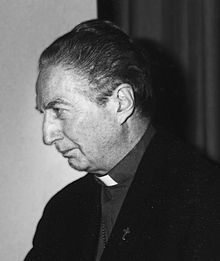Carlo Maria Martini | |
|---|---|
| Cardinal, Archbishop Emeritus of Milan | |
 Martini in 1992 | |
| Church | Roman Catholic Church |
| Archdiocese | Milan |
| See | Milan |
| Appointed | 29 December 1979 |
| Installed | 10 February 1980 |
| Term ended | 11 July 2004 |
| Predecessor | Giovanni Colombo |
| Successor | Dionigi Tettamanzi |
| Other post(s) | Cardinal-Priest of Santa Cecilia in Trastevere (1983–2012) |
| Previous post(s) | |
| Orders | |
| Ordination | 13 July 1952 by Maurilio Fossati |
| Consecration | 6 January 1980 by Pope John Paul II |
| Created cardinal | 2 February 1983 by Pope John Paul II |
| Rank | Cardinal-Priest |
| Personal details | |
| Born | Carlo Maria Martini 15 February 1927 |
| Died | 31 August 2012 (aged 85) Gallarate, Italy |
| Buried | Cathedral of Milan, Italy |
| Nationality | Italian |
| Parents | Leonardo Martini Olga Maggia |
| Alma mater | |
| Motto | Pro veritate adversa diligere ("For the love of truth, dare to choose adverse situations") |
| Signature | |
| Coat of arms |  |
Carlo Maria Martini SJ (15 February 1927 – 31 August 2012) was an Italian Jesuit and Biblical scholar. He served as Archbishop of Milan from 1980 to 2004 and was elevated to the cardinalate in 1983.
Martini entered the Society of Jesus in 1944 and was ordained a priest in 1952. His appointment as Archbishop of Milan in 1980 was an unusual circumstance, as Jesuits are not traditionally named bishops.[1]
A towering intellectual figure, Martini was the liberal contender for the papacy in the 2005 conclave, following the death of Pope John Paul II. According to highly placed Vatican sources, Martini received more votes in the first round than Cardinal Joseph Ratzinger, the conservative candidate: 40 to 38. Ratzinger ended up with more votes in subsequent rounds and was elected Pope Benedict XVI.
Suffering from a rare form of Parkinson's disease, Martini retired as archbishop in 2004 and moved to the Pontifical Institute in Jerusalem. He died at the Jesuit Aloisianum College in Gallarate near Milan eight years later.
- ^ "Is Pope Francis still a Jesuit?". National Catholic Reporter. 18 March 2013. Retrieved 20 December 2018.